Enhanced Performance of Gold Nanoparticle-Modified Nickel–Iron Coatings for Sodium Borohydride Electrooxidation
Abstract
1. Introduction
2. Materials and Methods
2.1. Chemicals
2.2. Fabrication of NiFe and AuNPs-Modified NiFe
- Activation of Cu/PI by dipping it in a 0.5 g L−1 PdCl2 solution for 1 min, followed by rinsing with deionized water.
- Electroless plating of the NiFe coating onto the activated Cu/PI with Pd by immersing it in an electroless plating solution containing 0.14 M NiSO4, 1 mM FeSO4, 0.05 M EDTA, 0.1 M CH2(COONa)2, 0.2 M MB, and 0.2 M NH2CH2COOH (pH 7). The bath operated at 60 °C for 1 h.
2.3. Characterization of Materials
2.4. Electrochemical Measurements
2.5. Fuel Cell Test Experiments
3. Results and Discussion
4. Conclusions
Author Contributions
Funding
Data Availability Statement
Acknowledgments
Conflicts of Interest
Abbreviations
| AuNPs | Gold nanoparticles |
| BOR | Sodium Borohydride Oxidation Reaction |
| CV | Cyclic Voltammetry |
| CA | Chronoamperometry |
| CP | Chronopotentiometry |
| Cu/PI | Copper-coated polyimide |
| DBFCs | Direct Borohydride Fuel Cells |
| EDX ICP-OES | Energy-Dispersive X-ray Spectroscopy Inductively Coupled Plasma Optical Emission Spectroscopy |
| LSV | Linear Sweep Voltammetry |
| MB | Morpholine borane |
| NaBH4 | Sodium Borohydride |
| NaBH4-H2O2 | Sodium Borohydride–Hydrogen Peroxide Fuel Cell |
| PI | Polyimide |
| ORR | Oxygen Reduction Reaction |
| SEM | Scanning Electron Microscopy |
| SILAR | Successive Ionic Layer Adsorption and Reaction |
References
- Wang, J.; Ma, X.; Liu, T.; Liu, D.; Hao, S.; Du, G.; Kong, R.; Asiri, A.M.; Sun, X. NiS2 nanosheet array: A high-active bifunctional electrocatalyst for hydrazine oxidation and water reduction toward energy-efficient hydrogen production. Mater. Today Energy 2017, 3, 9–14. [Google Scholar] [CrossRef]
- Moradi, R.; Groth, K.M. Hydrogen storage and delivery: Review of the state-of-the-art technologies and risk and reliability analysis. Int. J. Hydrogen Energy 2019, 44, 12254–12269. [Google Scholar] [CrossRef]
- He, B.; Zhuang, S.; Tai, X.; Zhang, J.; Xie, A.; Cheng, L.; Song, P.; Tang, Y.; Chen, Y.; Wan, P. Carbon coated and nitrogen doped hierarchical NiMo-based electrocatalysts with high activity and durability for efficient borohydride oxidation. ACS Appl. Mater. Interfaces 2022, 14, 17631–17641. [Google Scholar] [CrossRef] [PubMed]
- Ma, J.; Choudhury, N.A.; Sahai, Y. A comprehensive review of direct borohydride fuel cells. Renew. Sustain. Energy Rev. 2010, 14, 183–199. [Google Scholar] [CrossRef]
- Yin, X.; Wang, Q.; Duan, D.; Liu, S.; Wang, Y. Amorphous NiB alloy decorated by Cu as the anode catalyst for a direct borohydride fuel cell. Int. J. Hydrogen Energy 2019, 44, 10971–10981. [Google Scholar] [CrossRef]
- Braesch, G.; Wang, Z.; Sankarasubramanian, S.; Oshchepkov, A.G.; Bonnefont, A.; Savinova, E.R.; Ramani, V.; Chatenet, M. A high-performance direct borohydride fuel cell using bipolar interfaces and noble metal-free Ni-based anodes. J. Mater. Chem. A 2020, 8, 20543–20552. [Google Scholar] [CrossRef]
- Oshchepkov, A.G.; Braesch, G.; Ould-Amara, S.; Rostamikia, G.; Maranzana, G.; Bonnefont, A.; Papaefthimiou, V.; Janik, M.J.; Chatenet, M.; Savinova, E.R. Nickel metal nanoparticles as anode electrocatalysts for highly efficient direct borohydride fuel cells. ACS Catal. 2019, 9, 8520–8528. [Google Scholar] [CrossRef]
- Xue, L.; Liu, C.; Ye, J.; Zhang, J.; Kang, L.; Zhang, Y.; Shi, W.; Guo, W.; Huang, X.; Yang, X.; et al. Engineering partially oxidized gold via oleylamine modifier as a high-performance anode catalyst in a direct borohydride fuel cell. ACS Appl. Mater. Interfaces 2024, 16, 39295–39304. [Google Scholar] [CrossRef]
- Zhiani, M.; Mohammadi, I. Performance study of passive and active direct borohydride fuel cell employing a commercial Pd decorated Ni–Co/C anode catalyst. Fuel 2016, 166, 517–525. [Google Scholar] [CrossRef]
- Santos, D.M.F.; Šljukić, B.; Amaral, L.; Milikić, J.; Sequeira, C.A.C.; Macciò, D.; Saccone, A. Nickel–rare earth electrodes for sodium borohydride electrooxidation. Electrochim. Acta 2016, 190, 1050–1056. [Google Scholar] [CrossRef]
- Li, Y.; Zhang, X.; Zhang, Q.; Zheng, J.; Zhang, N.; Chen, B.H.; Smith, K.J. Activity and kinetics of ruthenium supported catalysts for sodium borohydride hydrolysis to hydrogen. RSC Adv. 2016, 6, 29371–29377. [Google Scholar] [CrossRef]
- Cheng, K.; Jiang, J.; Kong, S.; Gao, Y.; Ye, K.; Wang, G.; Zhang, W.; Cao, D. Pd nanoparticles support on rGO-C@TiC coaxial nanowires as a novel 3D electrode for NaBH4 electrooxidation. Int. J. Hydrogen Energy 2017, 42, 2943–2951. [Google Scholar] [CrossRef]
- Yang, F.; Cheng, K.; Ye, K.; Wei, X.; Xiao, X.; Guo, F.; Wang, G.; Cao, D. High performance of Au nanothorns supported on Ni foam substrate as the catalyst for NaBH4 electrooxidation. Electrochim. Acta 2014, 115, 311–316. [Google Scholar] [CrossRef]
- Song, C.; Zhang, D.; Wang, B.; Cai, Z.; Yan, P.; Sun, Y.; Ye, K.; Cao, D.; Cheng, K.; Wang, G. Uniformly grown PtCo-modified Co3O4 nanosheets as a highly efficient catalyst for sodium borohydride electrooxidation. Nano Res. 2016, 9, 3322–3333. [Google Scholar] [CrossRef]
- Yi, L.; Meng, Y.; Wang, R.; Fei, J.; Wang, X.; Lu, Y. Carbon supported Pd–Sn nanoparticle eletrocatalysts for efficient borohydride electrooxidation. New J. Chem. 2020, 44, 13472–13479. [Google Scholar] [CrossRef]
- Duan, D.; Liang, J.; Liu, H.; You, X.; Wei, H.; Wei, G.; Liu, S. The effective carbon supported core–shell structure of Ni@Au catalysts for electro-oxidation of borohydride. Int. J. Hydrogen Energy 2015, 40, 488–500. [Google Scholar] [CrossRef]
- Duan, D.; Liu, H.; You, X.; Wei, H.; Liu, S. Anodic behavior of carbon supported Cu@Ag core–shell nanocatalysts in direct borohydride fuel cells. J. Power Sources 2015, 293, 292–300. [Google Scholar] [CrossRef]
- Duan, D.; Liu, H.; Wang, Q.; Wang, Y.; Liu, S. Kinetics of sodium borohydride direct oxidation on carbon supported Cu-Ag bimetallic nanocatalysts. Electrochim. Acta 2016, 198, 212–219. [Google Scholar] [CrossRef]
- Balčiūnaitė, A.; Tamašauskaitė-Tamašiūnaitė, L.; Santos, D.M.F.; Zabielaitė, A.; Jagminienė, A.; Stankevičienė, I.; Norkus, E. Au nanoparticles modified Co/titania nanotubes as electrocatalysts for borohydride oxidation. Fuel Cells 2017, 17, 690–697. [Google Scholar] [CrossRef]
- Zabielaitė, A.; Šimkūnaitė, D.; Balčiūnaitė, A.; Šimkūnaitė-Stanynienė, B.; Stalnionienė, I.; Naruškevičius, L.; Upskuvienė, D.; Selskis, A.; Tamašauskaitė-Tamašiūnaitė, L.; Norkus, E. Investigation of stability of gold nanoparticles modified zinc–cobalt coating in an alkaline sodium borohydride solution. Chemija 2020, 31, 210–223. [Google Scholar] [CrossRef]
- Tiwari, A.; Singh, V.; Nagaiah, T.C. Non-noble cobalt tungstate catalyst for effective electrocatalytic oxidation of borohydride. ACS Appl. Mater. Interfaces 2019, 11, 21465–21472. [Google Scholar] [CrossRef]
- Zhang, D.; Cheng, K.; Shi, N.; Guo, F.; Wang, G.; Cao, D. Nickel particles supported on multi-walled carbon nanotubes modified sponge for sodium borohydride electrooxidation. Electrochem. Commun. 2013, 35, 128–130. [Google Scholar] [CrossRef]
- Oshchepkov, A.G.; Braesch, G.; Rostamikia, G.; Bonnefont, A.; Janik, M.J.; Chatenet, M.; Savinova, E.R. Insights into the borohydride electrooxidation reaction on metallic nickel from operando FTIRS, on-line DEMS and DFT. Electrochim. Acta 2021, 389, 138721. [Google Scholar] [CrossRef]
- Çelikkan, H.; Şahin, M.; Aksu, M.L.; Veziroğlu, T.N. The investigation of the electrooxidation of sodium borohydride on various metal electrodes in aqueous basic solutions. Int. J. Hydrogen Energy 2007, 32, 588–593. [Google Scholar] [CrossRef]
- Tamasauskaite-Tamasiunaite, L.; Lichusina, S.; Balciunaite, A.; Zabielaite, A.; Simkunaite, D.; Vaiciuniene, J.; Selskis, A.; Norkus, E. Zinc-cobalt alloy deposited on the titanium surface as electrocatalysts for borohydride oxidation. ECS Trans. 2014, 61, 49. [Google Scholar] [CrossRef]
- Braesch, G.; Oshchepkov, A.; Bonnefont, A.; Maranzana, G.; Rostamikia, G.; Janik, M.J.; Savinova, E.; Chatenet, M. Electrodeposited Ni-based electrodes for high-performance borohydride oxidation reaction. Meet. Abstr. 2021, MA2021-01, 1916. [Google Scholar] [CrossRef]
- Santos, D.M.F.; Sequeira, C.A.C. Zinc anode for direct borohydride fuel cells. J. Electrochem. Soc. 2009, 157, B13. [Google Scholar] [CrossRef]
- Geng, X.; Zhang, H.; Ye, W.; Ma, Y.; Zhong, H. Ni–Pt/C as anode electrocatalyst for a direct borohydride fuel cell. J. Power Sources 2008, 185, 627–632. [Google Scholar] [CrossRef]
- Duan, D.; You, X.; Liang, J.; Liu, S.; Wang, Y. Carbon supported Cu-Pd nanoparticles as anode catalyst for direct borohydride-hydrogen peroxide fuel cells. Electrochim. Acta 2015, 176, 1126–1135. [Google Scholar] [CrossRef]
- Venugopal, A.; Aluha, J.; Scurrell, M.S. The water-gas shift reaction over Au-based, bimetallic catalysts. The Au-M (M= Ag, Bi, Co, Cu, Mn, Ni, Pb, Ru, Sn, Tl) on Iron (III) oxide system. Catal. Lett. 2003, 90, 1–6. [Google Scholar] [CrossRef]
- Naruškevičius, L.; Tamašauskaitė-Tamašiūnaitė, L.; Žielienė, A.; Jasulaitienė, V. A Co-based surface activator for electroless copper deposition. Surf. Coat. Technol. 2012, 206, 2967–2971. [Google Scholar] [CrossRef]
- Norkus, E.; Tamašauskaitė-Tamašiūnaitė, L. Application of Electroless Metal Deposition and Galvanic Displacement for Fabrication of Catalysts for Borohydride Oxidation. In Encyclopedia of Interfacial Chemistry: Surface Science and Electrochemistry; Wandelt, K., Ed.; Elsevier: Amsterdam, The Netherlands, 2018; Volume 5, pp. 361–372. [Google Scholar] [CrossRef]
- Jing, P.; Liu, M.; Pu, Y.; Cui, Y.; Wang, Z.; Wang, J.; Liu, Q. Dependence of phase configurations, microstructures and magnetic properties of iron-nickel (Fe-Ni) alloy nanoribbons on deoxidization temperature in hydrogen. Sci. Rep. 2016, 6, 37701. [Google Scholar] [CrossRef] [PubMed]
- Gyenge, E. Electrooxidation of borohydride on platinum and gold electrodes: Implications for direct borohydride fuel cells. Electrochim. Acta 2004, 49, 965–978. [Google Scholar] [CrossRef]
- Liu, B.H.; Li, Z.P.; Suda, S. Anodic oxidation of alkali borohydrides catalyzed by nickel. J. Electrochem. Soc. 2003, 150, A398–A402. [Google Scholar] [CrossRef]
- Hosseini, M.G.; Abdolmaleki, M.; Ashrafpoo, S. Electrocatalytic oxidation of sodium borohydride on a nanoporous Ni/Zn-Ni electrode. Chin. J. Catal. 2012, 33, 1817–1824. [Google Scholar] [CrossRef]
- Robertson, P.M. On the oxidation of alcohols and amines at nickel oxide electrodes: Mechanistic aspects. J. Electroanal. Chem. Interf. Electrochem. 1980, 111, 97–104. [Google Scholar] [CrossRef]
- Aytaç, A.; Gürbüz, M.; Elif Sanli, A. Electrooxidation of hydrogen peroxide and sodium borohydride on Ni deposited carbon fiber electrode for alkaline fuel cells. Int. J. Hydrogen Energy 2011, 36, 10013–10021. [Google Scholar] [CrossRef]
- Zhang, C.; Park, S.M. The anodic oxidation of nickel in alkaline media studied by spectroelectrochemical techniques. J. Electrochem. Soc. 1987, 134, 2966–2970. [Google Scholar] [CrossRef]
- Kuczyński, M.; Mikołajczyk, T.; Pieroźyński, B. Alkaline water splitting by Ni-Fe nanoparticles deposited on carbon fibre and nickel-coated carbon fibre substrates. Catalysts 2023, 13, 1468. [Google Scholar] [CrossRef]
- Wehrens-Dijksma, M.; Notten, P.H.L. Electrochemical quartz microbalance characterization of Ni(OH)2-based thin film electrodes. Electrochim. Acta 2006, 51, 3609–3621. [Google Scholar] [CrossRef]
- He, P.; Wang, X.; Liu, Y.; Liu, X.; Yi, L. Comparison of electrocatalytic activity of carbon-supported Au–M (M = Fe, Co, Ni, Cu and Zn) bimetallic nanoparticles for direct borohydride fuel cells. Int. J. Hydrogen Energy 2012, 37, 11984–11993. [Google Scholar] [CrossRef]
- Arevalo, R.L.; Escano, M.C.S.; Wang, A.Y.-S.; Kasai, H. Structure and stability of borohydride on Au(111) and Au3M(111) (M = Cr, Mn, Fe, Co, Ni) surfaces. Dalt. Trans. 2013, 42, 770–775. [Google Scholar] [CrossRef]
- Finkelstein, D.A.; Letcher, C.D.; Jones, D.J.; Sandberg, L.M.; Watts, D.J.; Abruña, H.D. Self-poisoning during BH4− oxidation at Pt and Au, and in situ poison removal procedures for BH4− fuel cells. J. Phys. Chem C 2013, 117, 1571–1581. [Google Scholar] [CrossRef]
- Nagle, L.C.; Rohan, J.F. Nanoporous gold anode catalyst for direct borohydride fuel cell. Int. J. Hydrogen Energy 2011, 36, 10319–10326. [Google Scholar] [CrossRef]
- Duan, D.; Yin, X.; Wang, Q.; Liu, S.; Wang, Y. Performance evaluation of borohydride electrooxidation reaction with ternary alloy Au–Ni–Cu/C catalysts. J. Appl. Electrochem. 2018, 48, 835–847. [Google Scholar] [CrossRef]
- Backović, G.; Milikić, J.; Negric, S.D.; Saccone, A.; Šljukić, B.; Santos, D.M.F. Enhanced borohydride oxidation kinetics at gold-rare earth alloys. J. Alloys Compn. 2021, 857, 158273. [Google Scholar] [CrossRef]
- Yi, L.; Wei, W.; Zhao, C.; Tian, L.; Liu, J.; Wang, X. Enhanced activity of Au–Fe/C anodic electrocatalyst for direct borohydride-hydrogen peroxide fuel cell. J. Power Sources 2015, 285, 325–333. [Google Scholar] [CrossRef]
- He, P.; Wang, Y.; Wang, X.; Pei, F.; Wang, H.; Liu, L.; Yi, L. Investigation of carbon supported Au–Ni bimetallic nanoparticles as electrocatalyst for direct borohydride fuel cell. J. Power Sources 2011, 196, 1042–1047. [Google Scholar] [CrossRef]
- Wei, J.L.; Wang, X.Y.; Wang, Y.; Guo, J.; He, P.Y.; Yang, S.; Li, N.; Pei, F.; Wang, Y.S. Carbon-supported Au hollow nanospheres as anode catalysts for direct borohydride−hydrogen peroxide fuel cells. Energy Fuels 2009, 23, 4037–4041. [Google Scholar] [CrossRef]
- Li, S.; Wang, L.; Chu, J.; Zhu, H.; Chen, Y.; Liu, Y. Investigation of Au@Co-B nanoparticles as anode catalyst for direct borohydride fuel cells. Int. J. Hydrogen Energy 2016, 41, 8583–8588. [Google Scholar] [CrossRef]
- Yi, L.; Song, Y.; Liu, X.; Wang, X.; Zou, G.; He, P.; Yi, W. High activity of Au–Cu/C electrocatalyst as anodic catalyst for direct borohydride-hydrogen peroxide fuel cell. Int. J. Hydrogen Energy 2011, 36, 15775–15782. [Google Scholar]
- Ponce de León, C.; Walsh, F.C.; Rose, A.; Lakeman, J.B.; Browning, D.J.; Reeve, R.W. A direct borohydride—Acid peroxide fuel cell. J. Power Sources 2007, 164, 441–448. [Google Scholar] [CrossRef]
- Atwan, M.H.; Macdonald, C.L.; Northwood, D.O.; Gyenge, E.L. Colloidal Au and Au-alloy catalysts for direct borohydride fuel cells: Electrocatalysis and fuel cell performance. J. Power Sources 2006, 158, 36–44. [Google Scholar] [CrossRef]
- Li, B.; Song, C.; Huang, X.; Ye, K.; Cheng, K.; Zhu, K.; Yan, J.; Cao, D.; Wang, G. A novel anode for direct borohydride-hydrogen peroxide fuel cell: Au nanoparticles decorated 3D self-supported reduced graphene oxide foam. ACS Sustain. Chem. Eng. 2019, 7, 11129–11137. [Google Scholar] [CrossRef]
- Li, B.; Yan, Q.; Song, C.; Yan, P.; Ye, K.; Cheng, K.; Zhu, K.; Yan, J.; Cao, D.; Wang, G. Reduced graphene oxide foam supported CoNi nanosheets as an efficient anode catalyst for direct borohydride hydrogen peroxide fuel cell. Appl. Surf. Sci. 2019, 491, 659–669. [Google Scholar] [CrossRef]
- Duan, D.; Feng, J.; You, X.; Zhou, X.; Wang, Y.; Chen, L.; Liu, S. Evaluation of Co–Au bimetallic nanoparticles as anode electrocatalyst for direct borohydride-hydrogen peroxide fuel cell. Ionics 2021, 27, 3521–3532. [Google Scholar]
- Yu, J.; Hu, B.; Xu, C.; Meng, J.; Yang, S.; Li, Y.; Zhou, X.; Liu, Y.; Yu, D.; Chen, C. An efficient Ni–P amorphous alloy electrocatalyst with a hierarchical structure toward borohydride oxidation. Dalton Trans. 2021, 50, 10168–10179. [Google Scholar] [CrossRef]
- Milikić, J.; Tapia, A.; Stamenović, U.; Vodnik, V.; Otoničar, M.; Škapin, S.; Santos, D.M.; Šljukić, B. High-performance metal (Au, Cu)–polypyrrole nanocomposites for electrochemical borohydride oxidation in fuel cell applications. Int. J. Hydrogen Energy 2022, 47, 36990–37001. [Google Scholar] [CrossRef]
- Uzundurukan, A.; Akça, E.S.; Budak, Y.; Devrim, Y. Carbon nanotube-graphene supported bimetallic electrocatalyst for direct borohydride hydrogen peroxide fuel cells. Renew. Energy 2021, 172, 1351–1364. [Google Scholar] [CrossRef]
- Oh, T.H. Gold-based bimetallic electrocatalysts supported on multiwalled carbon nanotubes for direct borohydride–hydrogen peroxide fuel cell. Renew. Energy 2021, 163, 930–938. [Google Scholar]
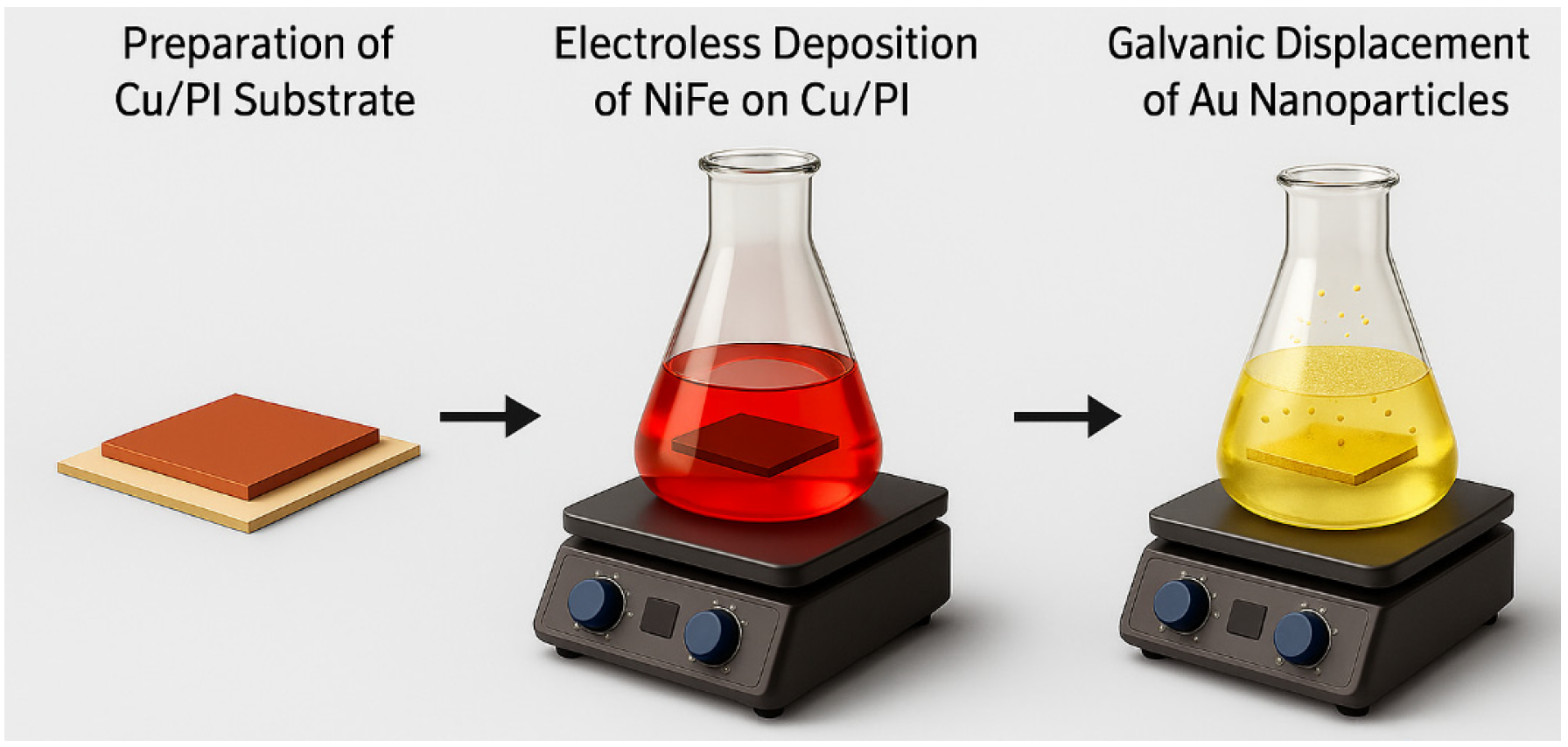
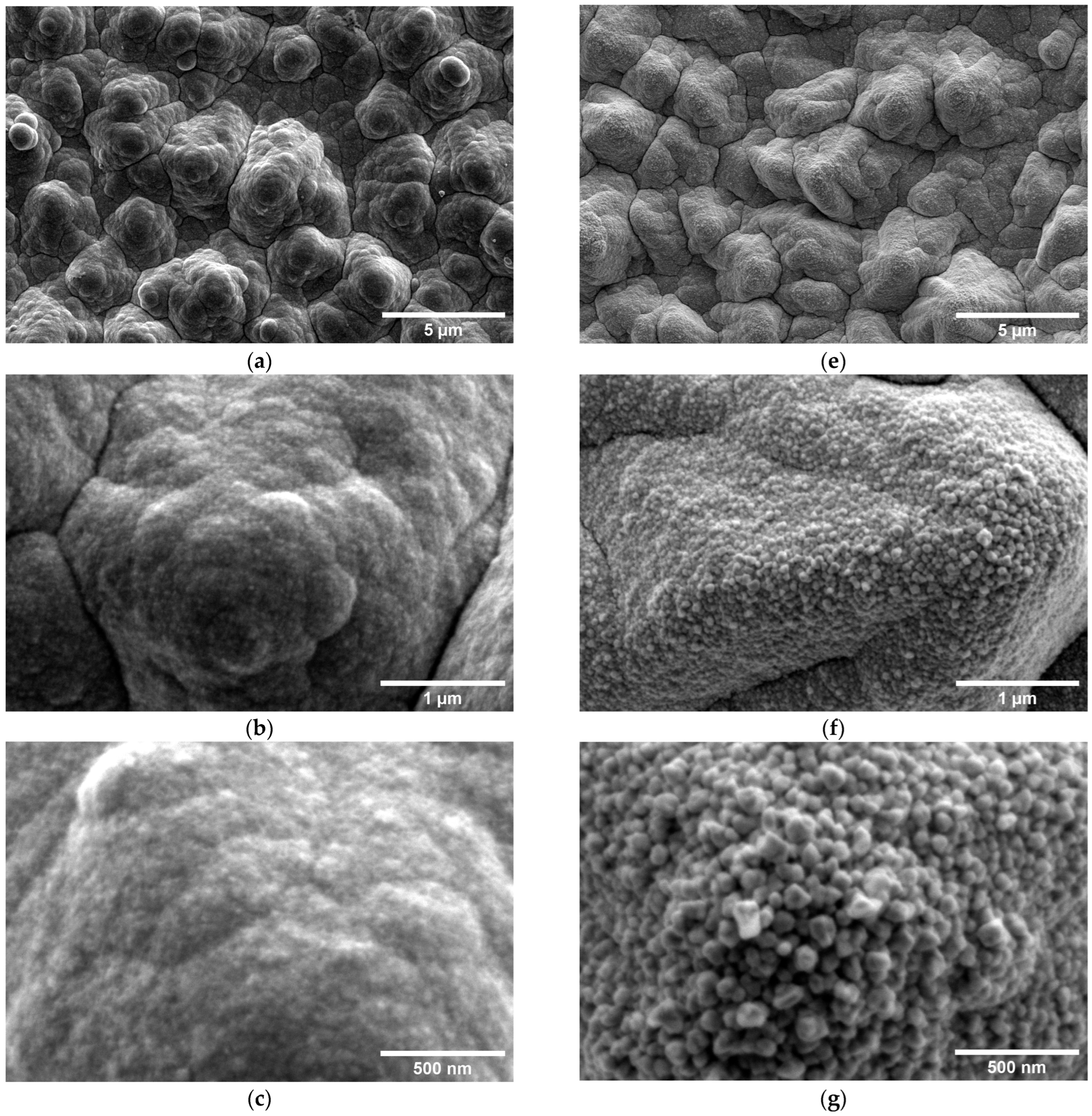
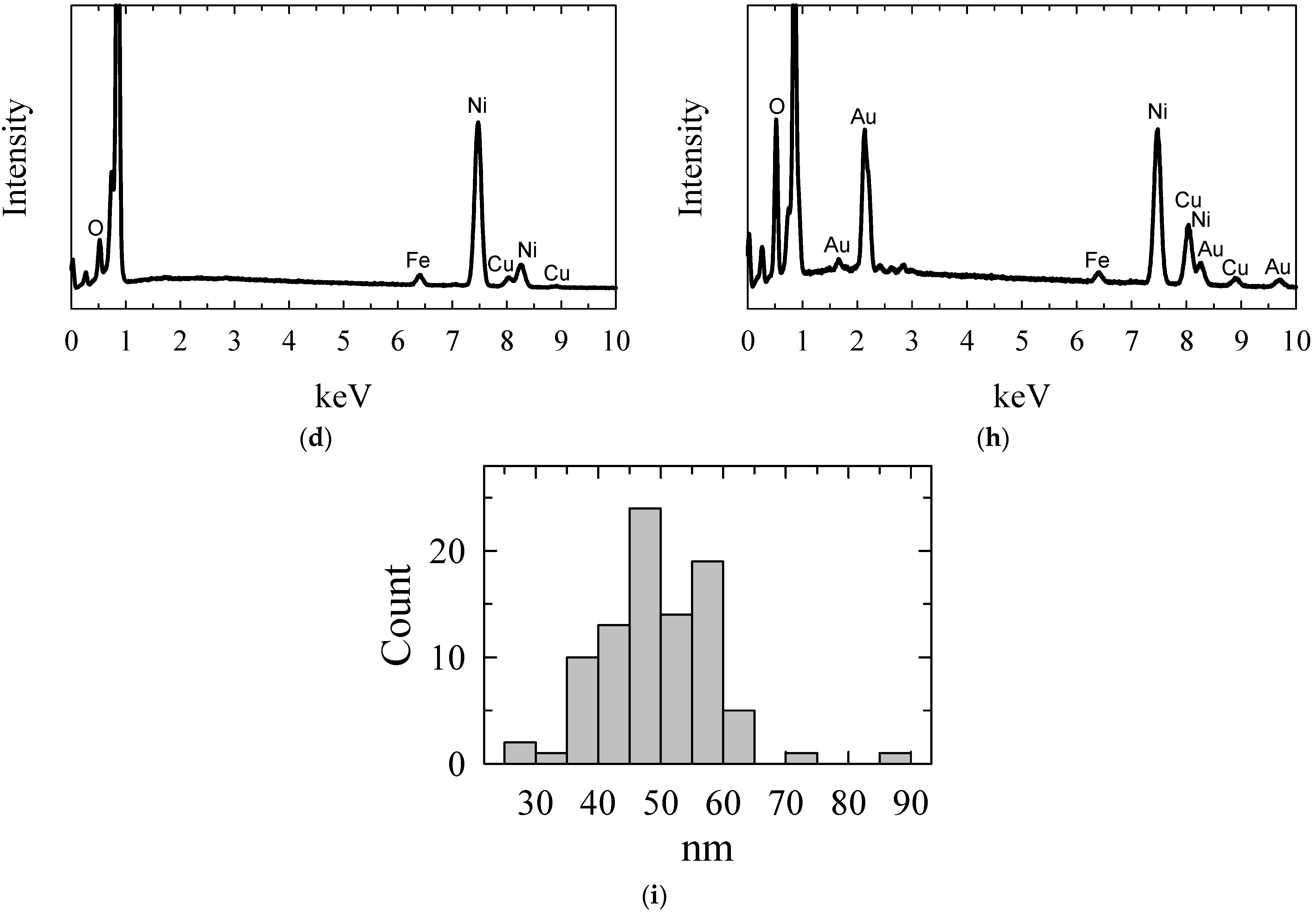
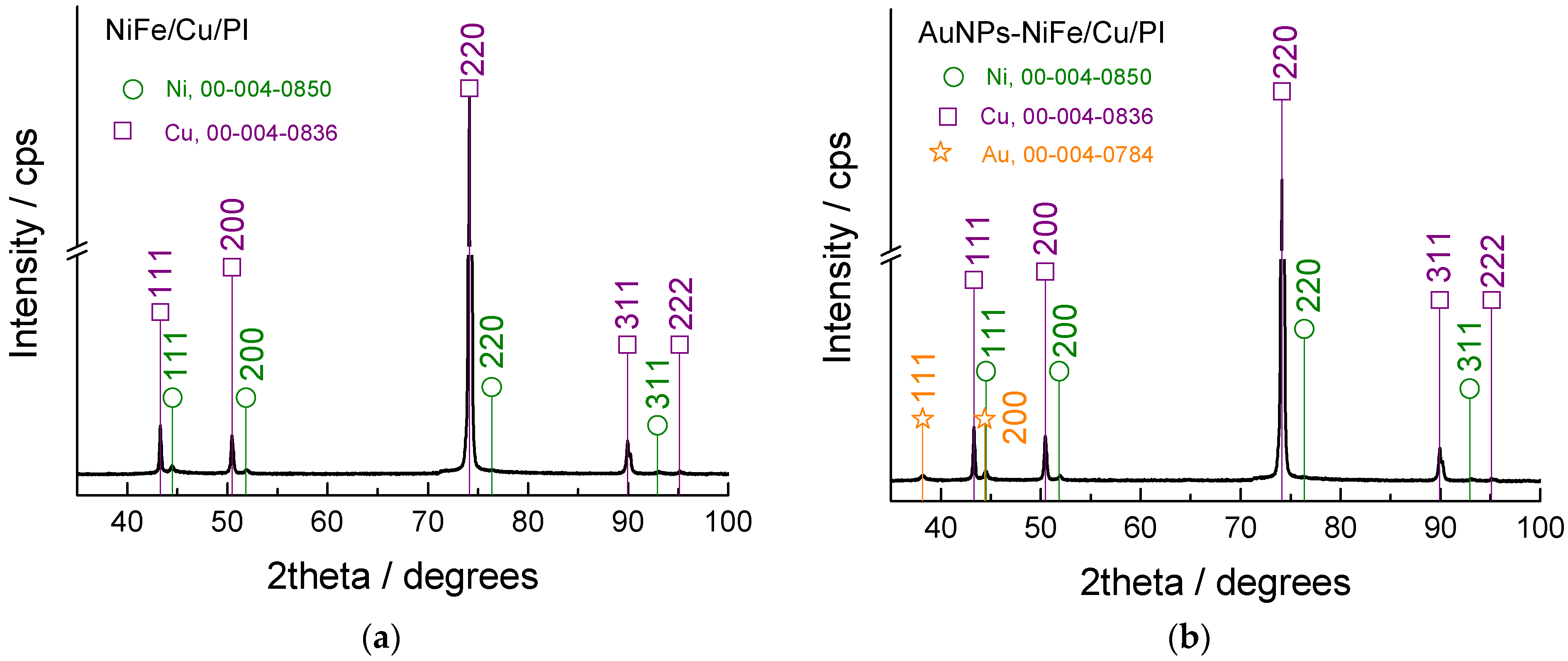
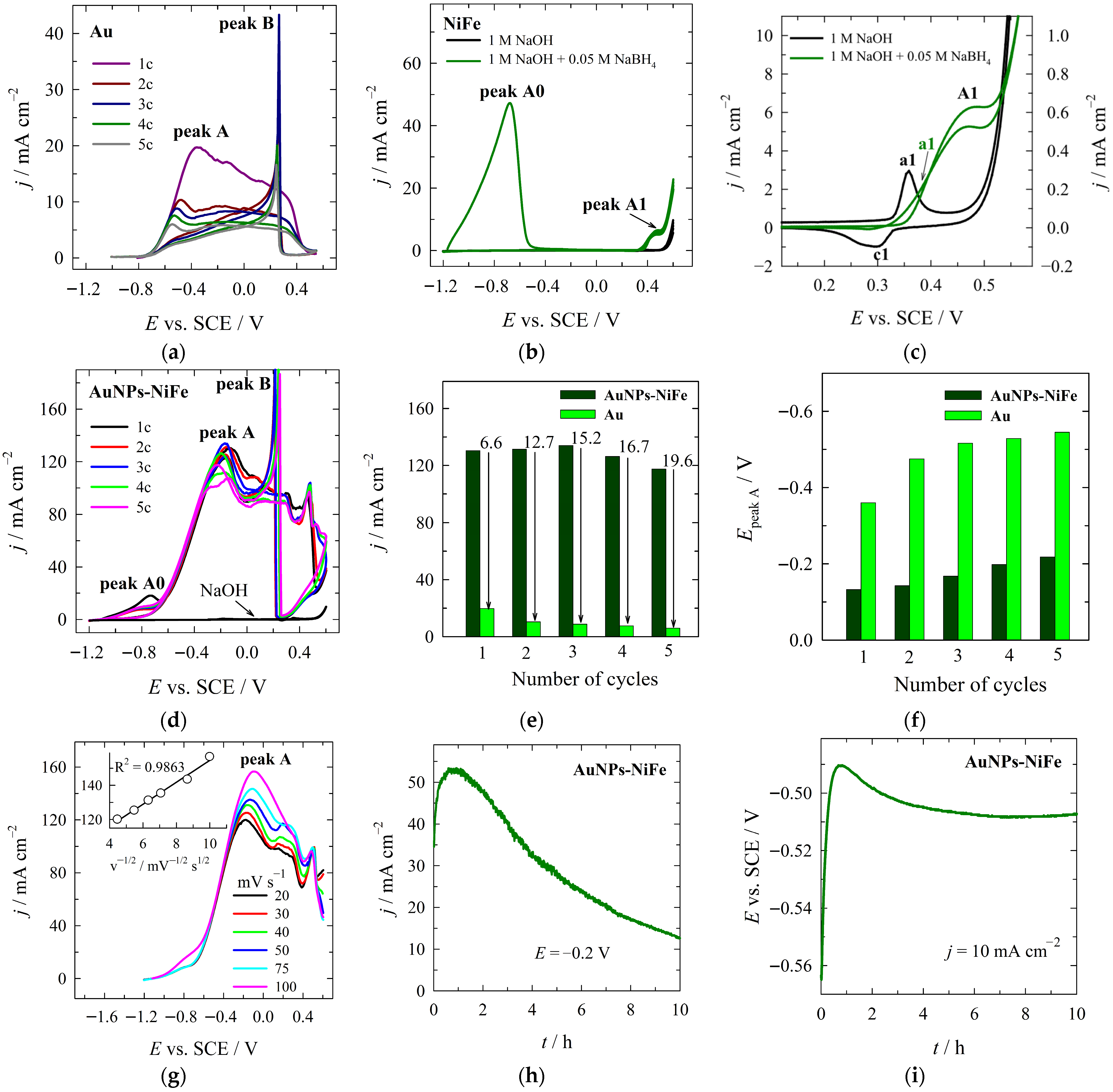
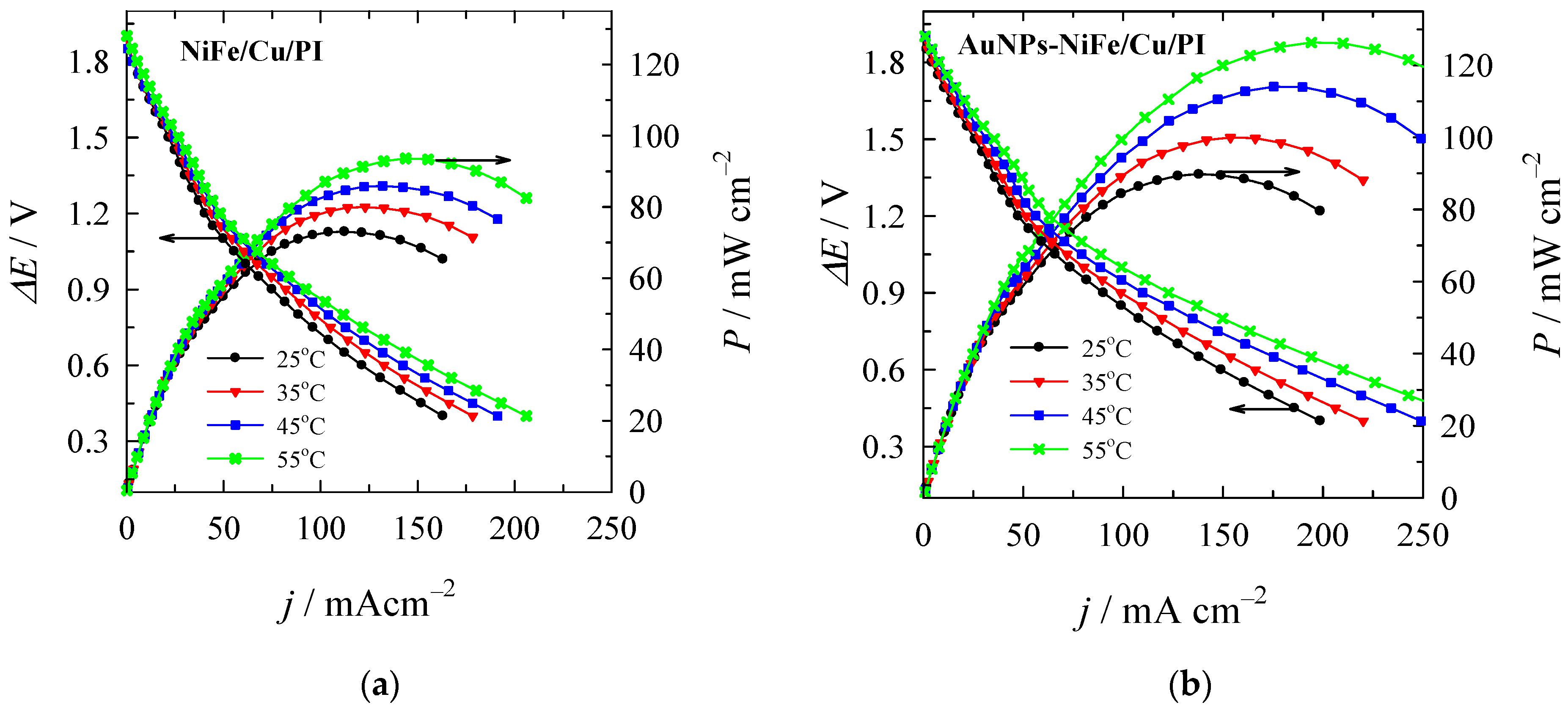
| Catalyst | Element, at% | ||
|---|---|---|---|
| Au | Ni | Fe | |
| NiFe | - | 96 | 4 |
| AuNPs-NiFe | 5 | 93 | 2 |
| Sample | Electrolyte | Scan Rate, mV s−1 | Peak Current Density, mA cm−2 | Ref. |
|---|---|---|---|---|
| NiFe/Cu/PI | 0.05 M NaBH4 + 1 M NaOH | 10 | 6.3 | This study |
| AuNPs-NiFe/Cu/PI | 0.05 M NaBH4 + 1 M NaOH | 10 | 133.9 | This study |
| Ni deposited carbon fiber | 0.8 M NaBH4 + 2 M NaOH | 50 | 56.0 | [38] |
| Ni/C | 0.2 M NaBH4 + 2 M NaOH | 50 | 18.0 | [28] |
| Leached Ni/Zn-Ni | 0.02 M NaBH4 + 1 M NaOH | 10 | 125.8 | [36] |
| Nanoporous gold wire array | 0.02 M NaBH4 + 1 M NaOH | 10 | 73.6 | [45] |
| Ni1@Au1/C | 0.03 M NaBH4 + 1 M NaOH | 50 | 26.0 | [16] |
| Au2Ni1Cu1/C | 0.1 M NaBH4 + 2 M NaOH | 50 | 61.4 | [46] |
| Au-Y | 0.03 M NaBH4 + 2 M NaOH | 50 | 34.0 | [47] |
| Au50Fe50/C | 0.1 M NaBH4 + 3 M NaOH | 20 | 33.8 | [48] |
| Sample | T, °C | Peak Power Density, mW cm−2 | Peak Power Density, mW µgAu−1 | Current Density at Peak Power Density, mA cm−2 | Cell Voltage at Peak Power Density, V |
|---|---|---|---|---|---|
| NiFe/Cu/PI | 25 | 73.1 | 4.4 | 112.3 | 0.65 |
| 35 | 80.0 | 4.8 | 122.9 | 0.65 | |
| 45 | 85.9 | 5.2 | 132.0 | 0.65 | |
| 55 | 93.6 | 5.7 | 143.9 | 0.65 | |
| AuNPs-NiFe/Cu/PI | 25 | 89.7 | 5.4 | 137.9 | 0.65 |
| 35 | 100.0 | 6.1 | 153.7 | 0.65 | |
| 45 | 114.1 | 6.9 | 175.4 | 0.65 | |
| 55 | 126.3 | 7.6 | 194.2 | 0.65 |
| Anode | Cathode | Anolyte | Catholyte | Pmax, mW cm−2 | T, °C | Ref. |
|---|---|---|---|---|---|---|
| NiFe/Cu/PI | Pt | 0.05 M NaBH4 + 1 M NaOH | 5 M H2O2 + 1.5 M HCl | 73.1 93.6 | 25 55 | [This work] |
| AuNPs-NiFe/Cu/PI | Pt | 0.05 M NaBH4 + 1 M NaOH | 5 M H2O2 + 1.5 M HCl | 89.7 126.3 | 25 55 | [This work] |
| Ni1@Au2/C | Pt mesh | 2 M NaOH + 0.5 M NaBH4 | 4.5 M H2O2 + 2 M HCl | 74 | 20 | [16] |
| Cu1Pd1/C | Pt mesh | 0.5 M NaBH4 + 2 M NaOH | 4.5 M H2O2 + 2 M HCl | 39.82 | 20 | [29] |
| Au50Fe50/C | Au/C | 0.1 M NaBH4 + 3 M NaOH | 2 M H2O2 + 0.5 M H2SO4 | 34.9 | 25 | [46] |
| Au58Ni42/C | Au/C | 1 M NaBH4 + 3 M NaOH | 2 M H2O2 + 0.5 M H2SO4 | 45.74 | 20 | [49] |
| HNAu/C | SNAu/C | 1 M NaBH4 + 3 M NaOH | 2 M H2O2 + 0.5 M H2SO4 | 25.8 | 20 | [50] |
| Au@Co-B | LaCoO3 | 0.8 M KBH4 + 6 M NaOH | Air | 85 | 25 | [51] |
| Au075Cu25/C | Au/C | 3 M NaOH + 1 M NaBH4 | 2 M H2O2 + 0.5 M H2SO4 | 37.4 | 25 | [52] |
| Au/C | Pt/C | 25% NaBH4 + 6 M NaOH | 1 M H2O2 + 1 M HCl + 3 M NaCl | 34 | 20 | [53] |
| Au/C | Pt/C | 1 M NaBH4 + 3 M NaOH | 0.15 M H2O2 + 1 M HCl | 25 | 25 | [54] |
| Au-NP@rGO foam | Pd/C | 0.4 M NaBH4 + 2 M NaOH | 0.8 M H2O2 + 2 M H2SO4 | 60 | 30 | [55] |
| CoNi-NS/Ni foam | Pd/Ti | 0.5 M NaBH4 + 4 M NaOH | 0.8 M H2O2 + 2 M H2SO4 | 80.6 140 | 30 60 | [56] |
| Co4-Au1/C | Pt mesh | 0.1 M NaBH4 + 2 M NaOH | 4.5 M H2O2 + 2 M HCl | 102.4 | 25 | [57] |
| Ni–P@NF | Pt sheet | 3 M NaOH + 1 M NaBH4 | 0.5 M H2SO4 + 2 M H2O2 | 52.5 | 25 | [58] |
| AuPPy-C | Pt mesh | 2 M NaOH + 0.03 M NaBH4 | 1.5 M HCl + 5 M H2O2 | 74.6 | 25 | [59] |
| Au/CNT-G | Pt/C | 2 M NaBH4 + 6 M NaOH | 2 M H2O2 + 1 M HCl | 125 | 50 | [60] |
| Au/MWCNTs | Au/MWCNTs | 5 wt% NaBH4 + 10 wt% NaOH + 85 wt% H2O | 20 wt% H2O2 + 5 wt% H3PO4 + 75 wt% H2O | 74 | - | [61] |
Disclaimer/Publisher’s Note: The statements, opinions and data contained in all publications are solely those of the individual author(s) and contributor(s) and not of MDPI and/or the editor(s). MDPI and/or the editor(s) disclaim responsibility for any injury to people or property resulting from any ideas, methods, instructions or products referred to in the content. |
© 2025 by the authors. Licensee MDPI, Basel, Switzerland. This article is an open access article distributed under the terms and conditions of the Creative Commons Attribution (CC BY) license (https://creativecommons.org/licenses/by/4.0/).
Share and Cite
Amber, H.; Zabielaitė, A.; Balčiūnaitė, A.; Nacys, A.; Shyshkin, D.; Šimkūnaitė-Stanynienė, B.; Mockus, Z.; Vaičiūnienė, J.; Tamašauskaitė-Tamašiūnaitė, L.; Norkus, E. Enhanced Performance of Gold Nanoparticle-Modified Nickel–Iron Coatings for Sodium Borohydride Electrooxidation. Crystals 2025, 15, 819. https://doi.org/10.3390/cryst15090819
Amber H, Zabielaitė A, Balčiūnaitė A, Nacys A, Shyshkin D, Šimkūnaitė-Stanynienė B, Mockus Z, Vaičiūnienė J, Tamašauskaitė-Tamašiūnaitė L, Norkus E. Enhanced Performance of Gold Nanoparticle-Modified Nickel–Iron Coatings for Sodium Borohydride Electrooxidation. Crystals. 2025; 15(9):819. https://doi.org/10.3390/cryst15090819
Chicago/Turabian StyleAmber, Huma, Aušrinė Zabielaitė, Aldona Balčiūnaitė, Antanas Nacys, Dmytro Shyshkin, Birutė Šimkūnaitė-Stanynienė, Zenius Mockus, Jūratė Vaičiūnienė, Loreta Tamašauskaitė-Tamašiūnaitė, and Eugenijus Norkus. 2025. "Enhanced Performance of Gold Nanoparticle-Modified Nickel–Iron Coatings for Sodium Borohydride Electrooxidation" Crystals 15, no. 9: 819. https://doi.org/10.3390/cryst15090819
APA StyleAmber, H., Zabielaitė, A., Balčiūnaitė, A., Nacys, A., Shyshkin, D., Šimkūnaitė-Stanynienė, B., Mockus, Z., Vaičiūnienė, J., Tamašauskaitė-Tamašiūnaitė, L., & Norkus, E. (2025). Enhanced Performance of Gold Nanoparticle-Modified Nickel–Iron Coatings for Sodium Borohydride Electrooxidation. Crystals, 15(9), 819. https://doi.org/10.3390/cryst15090819









